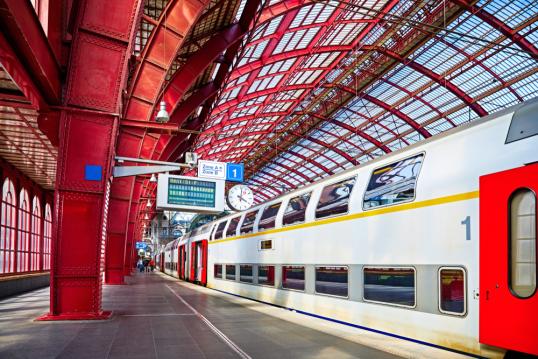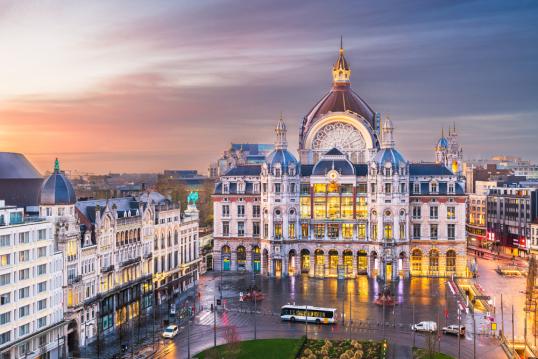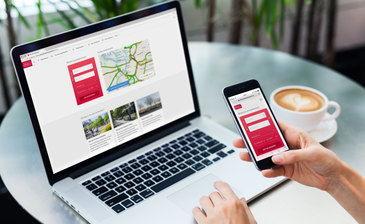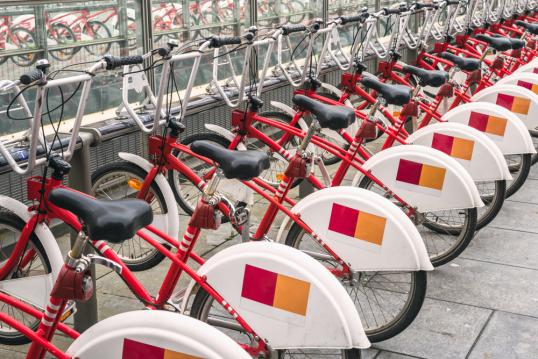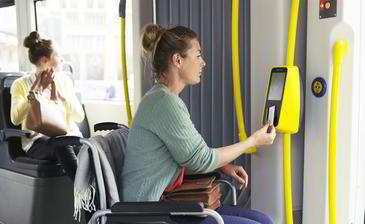- Topic
- Intermodality
- Mobility management
- Country
- Belgium
- Resource type
- Case study
First published on 26 Oct 2023
Even though it started as an initiative to keep the city of Antwerp accessible during periods of intensive road works, ‘Smart Ways to Antwerp’ has become an integral part of the city’s SUMP and regional strategy to promote sustainable urban mobility. In addition, it has become a platform for cooperation between public and private sector stakeholders on the implementation of a range of new mobility solutions.
Antwerp, located in Belgium, is a vibrant historic city known for its fashion, art, architecture, and culinary delights. It has an extensive business sector and tourist/leisure appeal. It also has one of the largest ports in Europe with a large industrial area and extensive logistics. The region has a population of 1.1 million, which has been growing by roughly 8,000 inhabitants per year over the past decade. More than half a million people live in the city of Antwerp.
Keeping the city and region accessible and liveable is a challenge. How to reconcile the large and growing freight flow to and from the port, and passenger movements in the city with flows of commuters, visitors and inhabitants, is part of that challenge. An important pillar of the strategy to deal with this challenge is the ‘Smart Ways to Antwerp’ initiative. The City of Antwerp uses this initiative to actively invest in behavioural change, with targeted campaigns, clear communication, multimodal advice on different routes, and the development of new mobility solutions and partnerships.
Context
In 2016, Antwerp initiated discussions on the completion of its ring road, which spurred a broad debate on the sustainable spatial development of the city, including its mobility system. From these discussions emerged the ‘Alliance for the Future’ (Toekomstverbond), an agreement between the Flemish government, the City of Antwerp, the Antwerp Port Authority and citizen movements to offer better mobility options and improve the quality of life in the Antwerp region. The pillars of the Alliance were: the completion of the ring road and its use for local and regional traffic; the creation of a bypass for through traffic and traffic directed towards the port; the direction of road traffic underground by putting a roof over the ring road; a target for a modal shift where at least 50% of trips would use sustainable modes; and an agreement between all stakeholders to work intensively together to implement the agreement. The initiative helped shape the design of a €1.3 billion programme, the Big Link, for the development of the ring road and the creation of large green spaces, to be partially created by covering the ring road over a length of almost 20 km. It also laid the foundations for a shift towards sustainable transport modes and led to the regional mobility plan ‘Routeplan 2030’ developed by the Antwerp Transport Region - covering 32 surrounding municipalities and involving all relevant stakeholders. The ‘Smart Ways to Antwerp’ initiative plays a crucial role in both the Big Link programme and the ‘Routeplan 2030’ mobility plan.
In action
The ‘Smart Ways to Antwerp’ initiative started in 2016 as an initiative to maintain accessibility in and around the city during the various major infrastructure works in the Antwerp area, and in anticipation of the ‘Big Link’ programme road works in years to come. The ‘Smart Ways to Antwerp’ initiative’s goal was to keep road users informed and help them to avoid disruptions by offering alternative routes to all road users. However, the scope of ‘Smart Ways to Antwerp’ rapidly expanded.
To bring about modal shift and reduce congestion, people need to be convinced to alter their behaviour. That can happen through:
- Modal shift: meaning a shift from the car to more sustainable transport options.
- Time shift: meaning travel before or after peak hours, or avoiding travel, if possible, for example, by encouraging companies to implement flexible work schedules, by transporting containers outside of office hours, or by responding to live traffic updates in order to travel at different times, etc.
- Location shift: meaning the location is altered so that congested areas are avoided. For example, freight is redirected to local distribution hubs or commuters are encouraged to use co-working spaces, rather than work in the city centre.
- Technology shift: meaning the implementation of new technology to optimise travel flow and enable sustainable behaviour, for example, with the introduction of carpool platforms container flow optimisation platforms, Mobility as a Service (MaaS) applications, etc.
In order to make these shifts appealing, people need to have good alternatives available to them. Transport services need to be developed, infrastructure needs to be in place, and people need to be informed about the different alternatives. People need to know that alternatives exist, how to use them, how to plan their journey, and understand the potential benefits of these alternatives. Moreover, alternatives can also include multimodal travel, where one part of a journey shifts to another transport mode. For this to happen, people need to know about the different possibilities, as planning a seamless multimodal journey can be perceived as cumbersome, even if one is aware of different possibilities. The ‘Smart Ways to Antwerp’ initiative recognised these needs. Therefore, its objectives changed quickly from informing people about upcoming road works, possible delays and alternative routes, to raising awareness and influencing behaviour away from car use, as well as to supporting the co-creation of mobility solutions and the creation of networks for cooperation with companies, mobility providers, authorities and civic movements.
Marketplace for mobility
An important part of the strategy to develop sustainable mobility alternatives is the Antwerp Marketplace for Mobility, a platform for partnerships with mobility service providers. It focuses on public and private providers of innovative mobility solutions that can contribute to a modal/time/location/technology shift for passenger and freight transport. As such, it also aims to facilitate the further development and integration of MaaS, shared mobility and public transport services.
Through the platform, the city has opened itself up to new mobility providers. Antwerp welcomes shared mobility initiatives as long as they meet some minimum quality standards in terms of their service offer, their support to users and transport providers, and financial guarantees for users and transport providers. In addition, MaaS and shared mobility providers also need to agree to share data and comply with standards to facilitate the exchange of these data. All shared mobility providers must provide the city with geographical data (e.g. the operational zone), real-time vehicle availability and anonymised movement data. All these data are processed and shared according to the guidelines of privacy legislation. The city uses these data to monitor, perform mobility analyses and check compliance with operating conditions. The regulations governing access to the market have been developing gradually, taking account of feedback from service providers in order to improve the framework.
Antwerp has deliberately chosen not to opt for a system with small MaaS pilots. Instead, Antwerp invites and allows service providers to come to Antwerp not to test, but to use the city as a living lab, to go beyond carrying out a pilot to see whether something works on a larger scale. In this way, potentially viable concepts are able to prove themselves. In addition, they receive support from the city.
Interested parties can become a partner if they are already working on optimising their services for sustainable mobility. They receive promotional and communications support from the ‘Smart Ways to Antwerp’ initiative. This is especially interesting for companies which would like to gain more visibility in the City of Antwerp. In addition, once or twice a year, the City of Antwerp launches an open call. Interested providers can submit a specific project aimed at reducing congestion to be rolled out within the year. Passenger transport providers, as well as logistic and freight companies, may apply. Selected projects receive extended (financial and non-financial) support from the City of Antwerp for the duration of the project. The implementation, progress and results are actively monitored. In early 2023, the latest call was launched for projects that contribute to smooth, efficient and sustainable passenger and freight traffic. Successful projects and campaigns that were selected include: Donkey Republic reduced e-bike subscription trial campaign; free Poppy shared cars for Antwerp Lucien customers, the Olympus2Work mobility app; and Medrepair discounted night transport containers.
Furthermore, the ‘Smart Ways to Antwerp’ initiative has supported the development of a fully functioning MaaS app, which outlines the various mobility solutions and provides users with a clear overview of travel options. It includes a multimodal route planner (including live navigation) providing the smartest, fastest, most active and cheapest routes and shows smart transport combinations, as well as high-quality cycling and walking routes. It also takes into account the low emission zone (LEZ), road works and diversions in and around Antwerp. The multimodal route planner also strives for the maximum integration of ticketing, which should contribute to its ease of use. The aim is that users can make the entire journey with a single ticket, regardless of the number of transport modes or the number of different transport providers they use during the journey. The ‘Smart Ways to Antwerp’ initiative helps mobility partners to access the MaaS-ecosystem and connect digitally with each other, through both financial and technical support.
Targeting different users
The ‘Smart Ways to Antwerp’ initiative has developed a shared marketing strategy addressing different target groups (residents, employees, visitors, companies, mobility providers, etc.), as each group requires its own approach and actions to achieve behavioural change in terms of sustainable mobility. For example, employers in the city and the port are encouraged to optimise their employees' commuting and make it more sustainable. Experienced accessibility managers support employers with 20 employees or more in developing a smart mobility policy. Employers receive tailor-made advice, insights into their employees' travel behaviour and potential changes, along with a wide range of specific solutions and services. This includes accessibility advice, a bicycle discount for employees, interesting partnerships with providers, advice on teleworking, a trial offer to try out alternative transport options, and so on.
Developing infrastructure
Different ways of moving also require different infrastructure and Antwerp is investing heavily into the necessary infrastructure. For example, Antwerp is developing its cycling network, not only within the city, but also to improve connections to the port and neighbouring municipalities. The city is also investing in bike stands. In addition, Antwerp now has 764 kilometres of slow roads where motorised transport is not allowed, providing a safer and more convenient network for cycling. To avoid generating traffic due to cars searching for parking spaces, the city is investing heavily in neighbourhood car parks, public car parks, Park and Ride facilities and underground car parks in new construction projects. This will free up more space on the street for residents and visitors to the city.
Paid and limited parking has been expanded in recent years to new and larger zones to keep the streets liveable for all of Antwerp’s residents:
- In 2013, 17.7% of the city (excluding the port) was paid parking or a blue zone; by 2022, this has increased to 31.1%.
- In addition, between 2017 and 2022, the number of parking spaces in Antwerp’s Park and Ride facilities increased from 1,116 to 4,319 (287% increase).
- Recently the number of normal street parking places in the centre have been minimised - as of 1 August 2023 a parking zone was introduced in the historic centre, where residents and holders of parking permits only are now allowed to park on the street.
- To better connect the Park and Ride facilities with other places in and around Antwerp by public transport, Antwerp has also been investing in the extension of tram lines.
Results
The ‘Smart Ways to Antwerp’ initiative has led to specific results, interesting insights and fruitful partnerships. It has shifted from being a short-term solution aimed at overcoming mobility issues during road works to a long-term strategy to tackle mobility challenges and improve accessibility in and around the Antwerp region and port. From 2016 onwards, the City of Antwerp developed an active stakeholder and partnership cooperation model. Thanks to a close cooperation within the sector, as well as transparency and mutual learning, the City of Antwerp has become a reliable and trustworthy partner in the mobility sector. Over the past six years, the number of shared mobility providers and private entrepreneurs partnering with the city has grown 2.5 times. Increasingly, instead of financial support, these partners turn to the Marketplace Platform for expertise and communications support from the city, showing the valuable role a city can play in the latter.
Together, the partners provide a rich variety of services and mobility options. After the shared bicycles and shared cars, the first shared electric scooters were launched in 2017, followed by shared electric cargo bikes in 2022. In 2022, the City of Antwerp had almost 10,000 shared vehicles, of which 170 were zero-emission cars. Shared bikes were used for more than 6 million trips in 2022.
The modal share of cars has been reducing over the years, especially for commuting. Last year (2022) was an important year for the modal split: for the first time, the bicycle had a larger share than the car in the commuting trips of Antwerp’s residents: 42.6% bicycle versus 36.2% car. In 2022, there were 46% more cyclists compared to 2015. The bicycle also continues to gain in popularity for trips to school (45% by bicycle) and in leisure time (42.8% by bicycle), while car use continues to decline.
The ‘Smart Ways to Antwerp’ initiative has also provided new practicality-oriented insights for policy-making. Because the city is actively involved in specific projects, thresholds and levers for innovation become visible. Projects lead to practical and experience-based policy advice. This process has already resulted in spotting opportunities and detecting needs for optimisation, such as: drafting an inland shipping bill; reviewing taxi regulations; and studying the possibilities of collective transport. In addition, the data obtained from the mobility service providers has contributed to improved mobility planning, which allows for an in-depth analysis of mobility patterns and trends in the City of Antwerp and its wider region.
Challenges, opportunities and transferability
A well-functioning market is essential to stimulate sustainable multimodality that places the end user at the centre. It requires a public authority that both supports and promotes the development of an integrated (physical and digital) offer, as well as the elimination of behaviour that undermines public policy objectives, through enforcement and market intervention.
Antwerp has been fostering inter-stakeholder collaboration (public and private) with supportive policies and regulations. It has embraced iterative, incremental and adaptive policy-making processes. Not only did it facilitate progress, it has also increased trust, participation and better policy implementation.
MaaS is an opt-in solution that provides benefit to users through economies of scale, integrated ticketing/payment, route-finding etc. It is not the basis of the transport system. Having a good walking and cycling network, in combination with incentives to leave the car at home can be very effective and should be incorporated in strategies. MaaS should be seen as a catalyst to assist in demand and supply management. Combined with management initiatives such as workplace travel planning, road and congestion pricing and emissions pricing management, MaaS can be an important means to improve the overall efficacy of the transport network and cities.
Antwerp has acknowledged that it needed both data standards and data sharing requirements. These were seen as a critical element in allowing the city to understand transportation use, to regulate companies and to incentivise and shape the behaviour of transportation companies in order to meet the city’s goals.
In Depth
The most important mobility figures for Antwerp from 2010 to 2022 are available online.
Author: Michael Modijefsky
Views and opinions expressed are those of the author(s) and do not reflect those of the European Commission.
Photo credits:
- 'Smart ways to Antwerp' website
- © Yasonya, Albert Pego and Sean Pavone / Shutterstock.com - no permission to re-use image(s) without separate licence from Shutterstock.

